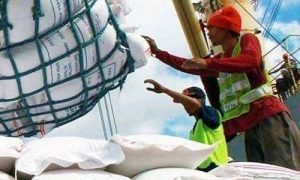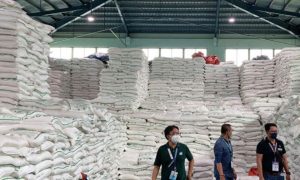FCSD should ensure quality of rice: Negi

Former Arunachal Pradesh chief secretary Ramesh Negi voiced concerns after reports revealed rice samples from Punjab, sent to Arunachal Pradesh, were found unfit for consumption, raising health issues for rural communities reliant on public distribution. Negi emphasized the importance of rigorous quality checks and recalled similar past incidents of food safety issues.
ITANAGAR, Oct 27: Reacting to report of ‘Rice samples sent from Punjab to Arunachal Pradesh found to be unfit for consumption’ as published in October 26 edition of this daily, former state chief secretary Ramesh Negi (02.02.14 to 08.03.16) has expressed deep concern.
The state people, mostly poor and downtrodden sections in far-flung and interior areas mostly depend of rice supplied by public distribution system of food and civil supplies department (FCSD).
Amid the ongoing political tug-of-war between the Centre and Punjab Govt over ‘tardy’ procurement of paddy, a new twist has emerged with 15 of the 19 samples collected from rice stocks at Banderdewa in Arunachal Pradesh, which were sent from Sangrur in Punjab, found to be ‘beyond rejection limit’ (BRL) and three found to be unfit for human consumption.
Union Ministry of Consumer Affairs, Food and Public Distribution subsequently shot off a letter to Food Corporation of India (FCI) urging it to ‘verify the quality of food grains preserved at all godowns’. The letter written by joint commissioner (storage and Research) of above Ministry to the FCI chairman on October 23, which reads, “This is in reference to the inspection conducted by the assistant director (S&R) of this department of the food storage deport (FSDs), depots in FCI district Banderdewa in Arunachal Pradesh with effect from September 16 to 21 last. During the inspection, total 19 rice samples were collected.”
Pointing out that send or broken or termite eaten rice mixed with pesticide is a serious issue, he said that it is the bonded duty of the FCSD to check quality of rice for permissible levels of pesticides and toxic to prevent any harm to the consumers.
Informing that wheat supplied by Punjab to Delhi in 1995 beyond permissible limit of pesticides and toxic was detected but then Govt had never brought it to public domain.
Negi, a 1984 batch AGMUT cadre IAS officer, with his coordination skills and deft presentations before 14th Finance Commission, had secured highest ever central grants for the state. He had given special emphasis on development of infrastructure in remote areas and conservation of rich environmental and cultural heritage and prevented misuse of Govt vehicles by introducing a strong mechanism.
Negi, who also occasionally visits this state as Integrated Mountain Initiative (IMI) president, in his inaugural address to 11th Meet of Mountain States (MoMS) at New Delhi on 23.03,24, had outlined MoMS-2024 objectives and told policymakers the need for greater mountain sensitivity of policies on disaster and allocation of appropriate financial resources to mitigate the collateral and multi-sectoral long-term damage.
MoMS is an annual event of Gangtok-based IMI that brings together policymakers, elected representatives, IMI partners, and other relevant agencies to jointly work on priority actions related to key mountain issues. The 11th MoMS, organized by the IMI coincided with World Water Day, themed “Water Resources in the Himalaya – Disaster Resilience and Reduction” with financial assistance of Arunachal Pradesh Govt, Uttarakhand Council for Science and Technology (UCOST) and Sustainable Development Forum of Uttarakhand (SDFU).
Uttarakhand Speaker Rita Khanduri, speaking as chief guest, had focused on ‘Geo Hydrology of the Himalayas and Disasters’ and called for urgent need of bridging research with policy and practice besides the need to fall back on good traditional practices with strong community engagement.
Elected representatives of Indian Himalayan Region, key policymakers, Govt department representatives, academia, researchers, funding agencies and IMI members from mountain states had taken part in the meet, which included a photography exhibition on recent Teesta Disaster.
With monsoon triggered incessant rainfall and cloudburst at Sagalee and in Kuurung Kumey district recently that had devastated Arunachal Pradesh disrupting surface communication, water and electricity supply throwing life out of gear cross the state, the IMI had begun to study impacts of climate change, cloudbursts, floods in hilly states, as published in 05.07.24 edition of this daily.
The IMI had launched macro assessment of Finance Commission (FC) grant allocation and its utilization by urban local bodies (ULBs) in hilly cities/states of India since June last.
The existing constraints faced by the ULBs are poor resource position due to lack of adequate commercial activities, high non-plan expenditure due to large workforce and periodic pay revision by state Govts; inadequate resource devolution due to SFC recommendations; very high cost on asset management, roads, retaining walls, culverts and bridges; annual asset loses due to climate change, cloudbursts, floods and forest fires; high material cost of plant and machinery; no potential for PPP or private investment due to small size of population specific grants needed; removal of legacy waste; recycling plants for plastic waste & compost plants; setting up of environment monitoring, assessment and awareness center for community engagement and motivation; community counselling centers for disaster affected people especially children and children affected by sexual abuse; preservation of traditional water bodies and springs and training center for sanitation staff and engineers.
With this objective, the IMI would take example from four selected ULBs across the Himalayan region. Through evidence-based research the study aims to suggest policy recommendations to the 16th FC. The assessment would cover Pasighat Municipal Council of Arunachal Pradesh, Municipal Corporations of Palampur (Himachal Pradesh), Rishikesh (Uttarakhand) and Aizwal (Mizoram), president Negi had told this daily.
It would analyze the trend of municipal finance grants/transfers of period of 14th and 15th FCs for hilly states and non-hilly states and growth rate of funds available as compared to population/GSDP rate and study share of revenue and grants in 14th FC vs 15th FC to assess the broad challenges for hilly states in effective utilization of grants/transfers.
The criteria for assessing “revenue sharing formulas” to ULBs in hilly states would be challenges faced in utilizing grants; fund allocation for “disaster risk management; role of state finance commissions (SFCs) and its implication and examining how the SFCs are instrumental in devolution of money to the ULBs.
The analysis would include selected study, like demographic and fiscal profiling; status of SFCs in relation to its constitution, devolution formula shared by SFCs for ULBs (vertical and horizontal); trend of municipal finance grants/transfers during period of 14th and 15th FCs; growth rate of funds available as compared to population/ GSDP rate; share of revenue and grants in 14th FC vs 15th FC; fund utilisation pattern and associated challenges. The study intended to give recommendations for the 16th FC grants based on its findings.
Negi, a down to earth personality, after handing over charge to Shakuntala Gamlin as next CS, had termed Arunachal as a “happening state”.
Source Link : https://arunachalobserver.org/2024/10/28/fcsd-should-ensure-quality-of-rice-negi/














